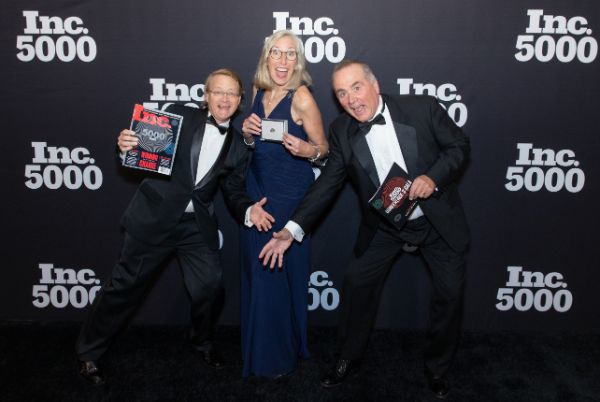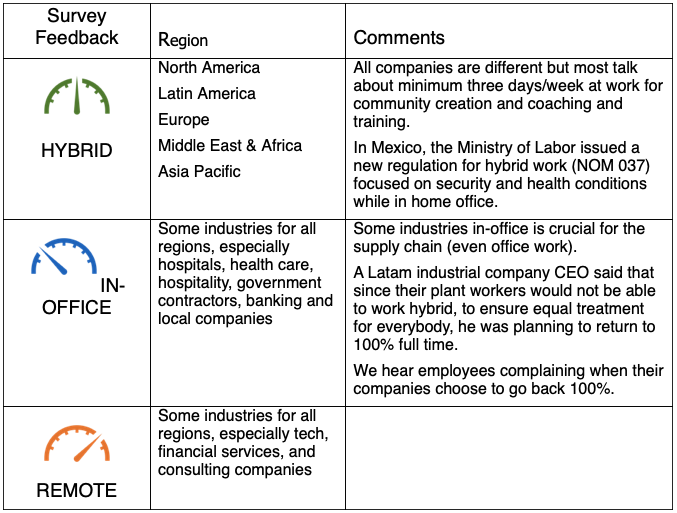
How to Design a Post-Pandemic Office
Thoughts from Jeff Wuest speaking at the
2022 Inc 5000 Conference
Last week, SynFiny Advisors did a survey of our clients around the globe – spanning countries such as Mexico, Costa Rica, Panama, Peru, US, UK, Austria, Dubai, Egypt, Singapore, Japan, Philippines, and India (see data below). We have a broad range of global clients. We’re seeing that return-to-office follows the industry of our clients, regional customs, and whether the client is local/regional/global. There is no one size fits all when it comes to the office of the future. A large majority of companies are all following some form of hybrid model.
The question of returning, staying remote, or going hybrid has no one right answer. It is a case-by-case answer, and all three can be the best answer for a company. The policy needs to be consistent with the company culture and meet the needs of local employment customs. What does your customer service require? Returning is often best in companies that find it difficult to maintain client or customer service without the employees being close by. Hospitals or hospitality are a couple industries with that situation. Government contractors stayed in-office because they had to. On the other hand, working remotely is best for companies that can maintain client or customer service virtually. Consulting or financial services are a couple industries that come to mind with good remote working environments. Hybrid work is best for those companies which fall in the middle. The customer or client needs some regular on-the-ground service which is only done by employees in the office.
The nurturing of company culture is the most difficult thing to maintain with remote working. This is one of the main concerns our clients have with remote working – followed by developing new staff, connecting with employees for higher retention, and continuing to train the organization.
Best practices today in companies focus on ways to connect by establishing events with employees. Scheduled trainings, formal events, or an informal happy hour, and get-to-know-you lunch are great ways to connect and build relationships. Management team or business development trips are also a good opportunity to connect. In the past, we only did business travel to visit the customer or client, but now we need to add in the same focus for our employees. Face-to-face interaction has key value. The best companies are finding ways to keep the employees connected and have fun while doing it.
In large all-hands settings or one-to-one, spending time talking about your core values and principles must be a priority. The organization needs to feel inspired by the vision of where we are all heading and how we make a difference in the world. That’s what keeps the team excited about being part of a company. It unifies us.
Companies that fail to maintain a strong culture will find it more and more difficult to compete with those that have established this connective fabric. The best employees will find the “best places to work” and leave from companies that treat everyone like employee badge numbers. Eventually, culture will impact the top and bottom lines of the company.
There’s difficulty when a business leader wants their team to return to the office full time, but employees aren’t necessarily keen. I think the business leader that wants to force their organization to return will need to think long and hard about that decision. That leader needs to look at what competitors are doing and what the clients or customers need. To bring people back, the leader needs to make a business case about survival – share the data that show why coming back to the office is critical to company survival and then accept the consequence of high turnover.
In today’s world, whether you are fully remote or in-person, fast-growing businesses can quickly scale. The most critical thing is a culture that is resilient in the face of inevitable adversity, including the start-up pains of rapid change. What is your on-boarding process? Does it start with your mission, vision, values, and culture? These keeps people together in the best and worst of times. It is critical to find the business model that best delivers the client or customer needs. It also has to be fun – that is the key to any successful growth company – people enjoy the work and believe in what they are doing.
There are many debates about productivity with remote work. I believe the move to remote working should not change the KPI’s of your company. You need to establish targets and track accordingly. The fact you now work remotely should not impact those targets. If you see the move to remote work is negatively impacting the company KPI’s, a change is needed. PERIOD. There are ways to build employee engagement with the company – tell stories about the exciting business results, find ways to recognize and reward strong performance, celebrate key moments in an employee’s life, and make it fun!

